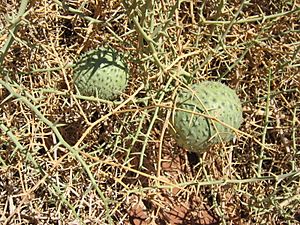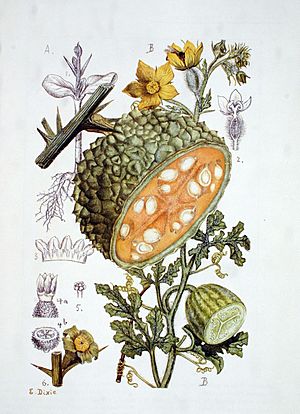Acanthosicyos horridus facts for kids
Quick facts for kids Acanthosicyos horridus |
|
|---|---|
 |
|
| Scientific classification | |
| Genus: |
Acanthosicyos
|
| Species: |
horridus
|
The Acanthosicyos horridus is a very special type of melon. It grows only in the Namib Desert in Africa. In English, people call it Nara, butter-nuts, or butterpips.
In some local Khoisan languages, it is known as ǃnaras or ǃnara. The "!" sound is a click, like the "tsk" sound people make sometimes.
About the Nara Plant
The Nara plant is quite unique. It has separate male and female plants, which is called dioecious. It doesn't have any leaves. Instead, its stems and spines do the work of making food from sunlight.
This plant is a phreatophyte. This means its roots grow very deep to reach underground water. Nara plants are found in sandy deserts, especially near old riverbeds where water is closer to the surface.
The plant's stems can grow more than a meter tall. Its thick taproots can go down up to 50 meters! The Nara plant can live for many years, even without much rain.
Nara's Role in the Desert
The Nara plant helps shape its environment. It binds sand, which creates small, sheltered areas called microclimates within the desert dunes. These spots offer food and shelter for many different animals.
Where Nara plants grow, the soil has more tiny living things. This is probably because the plant provides shade. Also, animals that eat the Nara add helpful organic matter to the soil.
The desert climate is very harsh, so Nara often grows alone. However, some grasses like Eragrostis spinosa and Stipagrostis sabulicola might grow around its sandy mounds.
The Nara is a very important plant, known as a keystone species. This means many other species depend on it. Its melons, seeds, shoots, and flowers are food for beetles, gemsbok, and ostrich. Small rodents, like Rhabdomys pumilio, Desmodillus auricularis, and Thallomys nigricauda, find shelter among its spiny stems. A type of katydid called Acanthoproctus diadematus also eats the plant.
How People Use Nara

The Nara melon fruits are usually about 1 kilogram (2.2 pounds) in weight. They are pale green and covered in spines. Inside, the fruit has a sweet, juicy, yellow-orange pulp.
The plant also has large, edible seeds. These seeds are white or cream-colored and are called butter-nuts or butterpips. They have even been sent to other countries to be used in baked goods.
The fruit is an important food source for the Nama people. They gather and eat the fruit from February to April and again from August to September.
See also
 In Spanish: Acanthosicyos horridus para niños
In Spanish: Acanthosicyos horridus para niños


